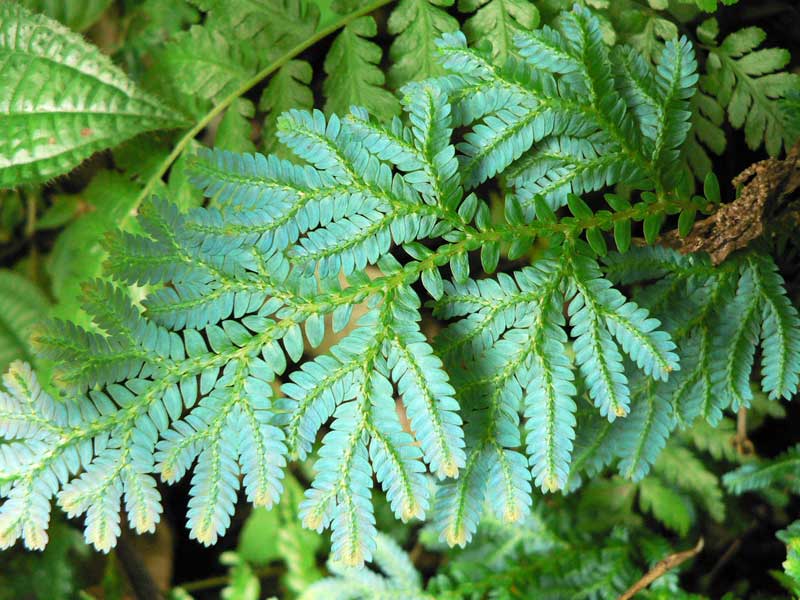|
Selaginella willdenowii (Desv. ex Poir.) Baker, Gard. Chron. 783, 950 1867. (Syn: Lycopodium willdenowii Desv. ex Poir.);
.
S. China to W. & Central Malesia: Andaman Is., Cambodia, China South-Central, China Southeast, Jawa, Laos, Malaya, Myanmar, Philippines, Sulawesi, Sumatera, Thailand, Vietnam; Introduced into: Colombia, Florida, Jamaica, Panamá, Puerto Rico, Queensland, Vanuatu as per POWO; . Selaginella Willdenowii – Need Info : 4 posts by 2 authors. Attachments (2).
I recently came accross this Selaginella willdenowii plant. I really like the blue irredescent leaves. There is also selaginella uncinata with blue leave again but I believe it is native to China/Thailand. Yes, those two do have a beautiful blue sheen, especially S. uncinata. There are some others, to – and better still S. haematodes from S. America, which I used to have growing, is bright scarlet beneath. The best of all, in my opinion is the common variegated form of S. picta, occurring in Arunachal Pradesh etc. (including Namdapha National Park), with tall, plasticy-looking bright white median leaves contrasting as a perfect white central area with the bright green laterals either side. If you had Pteris tricolor (scarlet, white and green) growing with all these, no one would believe they were all for real!
Bur you’d have to visit Botanic Gardens, like Singapore, and some German ones have S. haematodes. – though nowadays many won’t give out specimens to anyone due to a strict and totally stupid interpretation of their Garden CITES status. That really hampers all advances in horticulture and Botany – while India has destructive new laws preventing collection, including for scientific purposes, against the recommendation of their own scientific committee.
Despite misreports by Dixit and Panigrahi, S. willdenowii is not native to the Indian mainland – reports were all in error for the related, but less colourful S. helferi. But there is some S. wildenowii in Calcutta Botanic Garden, Palm house no. 2, where it grows rampantly. It occurs in the Andamans and Nicobars, and in Myanmar, Thailand, S. China and S.E. Asia. Some of the Pradhan nurseries at Kalimpong had S. uncinata a few years ago, so probably still now, and it is widespread at Botanical gardens abroad.
Bonn Botanic Garden, Germany, and various others have S. haematodes. No one has S. picta (the coloured form) so better visit Namdapha! Henry’s Plant Farm, U.S.A. (find it on Google), had genuine Pteris tricolor (from S. China, Mizoram, Myanmar) – while others claim to have it but in error and not so fine, and there’s also a very fine white striped Pteris different from S. Indian Pteris argyrea (with white stripes) at Bogor Botanic Garden, Java, on sale outside the garden there. Pteris scabririgens from Kalimpong, Darjeeling, Shillong etc. has most beautiful bright pink, stiff young fronds, contrasting with the dark green adult fronds. A variegated Selaginella menziesii also occurs in gardens abroad, including Oxford botanic Garden, U.K., with white areas of branches and leaves next to bright green areas.
It would be nice to set up a coloured fern garden! . Blue Fern – efloraofindia | Google Groups: 2 images. I had seen this fern about two years ago at a greenhouse in a botanical garden in Montreal. It was therefore very exciting to see it in the wild at the Bodogol National Park in Java, Indonesia. The blue is really unbelievable!
I attach some photos and apologise for sending images of non-Indian flora. It is not a Fern but Fern ally, Selaginella sps. but I dont know the sps name. This can be Selaginella willdenowii commonly referred to as Peacock Fern or Willdenow’s Spikemoss. Selaginella uncinata (Desv. ex Poir.) Spring Its a Selaginella, although its not really showing enough of it in these photos, I wonder if it climbs and straggles up bushes? If so it is almost certainly S. willdenowii. There are a few different Selaginellas that show that lovely almost metallic blue, but S. willdenowii is the best one. There are fine plants of it in the Acharya Chandra Bose National Botanic Garden, Kolkata (in “Round House no. 2). |


